Handmark
Handmark were showing off their Pocket Express product. This is already well established in the US and Handmark is now bringing the product to Europe. Pocket Express acts as a 'service aggregator', combining a number of useful information sources (such as weather, stock quotes, directory enquiries and cinema times) into a single application. The European version is currently Java-based, but a native Symbian version of the program will be coming out later in the year. Handmark are currently setting up the necessary content agreements to provide a localised version of the product for the respective European markets.
Fring
Fring were on hand to demo their VoIP and IM client solution. Fring provides a single application to interface with various IM and voice networks. They have received a lot of attention for implementing a working Skype solution (both voice and text), along with Google Talk, MSN and a generic SIP Client.
One of the early issues with using Fring was that it tended to drain the battery relatively quickly. Boaz Zilberman, one of the co-founders of Fring, said that they are continuing to work on this problem and significant improvements have been made in the 3.0 release. Fring has also taken advantage of some of the changes in S60 3rd Edition Feature Pack 1 and Symbian 9.2, such as using the new voice driver support, to improve battery life. Boaz also shared some interesting stats about Fring users. He said that the average time that a Fring user was logged on for had increased from 3 hours to 4 hours, which was indicative of the lower power consumption. He also explained that while 30% of users only use 1 network, 70% use more than one, suggesting that Fring is gaining in popularity as a way of integrating a number of services into a single application.

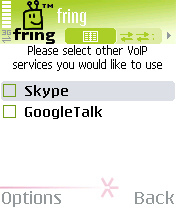
DataViz
DataViz were showing off version 3.0 of their Exchange Sync product RoadSync. The new version, which runs on all S60 3rd Edition devices, supports many of the new features found in Microsoft Exchange 2007, such as on-line mailbox searching (great for access to older email), email flags and faster message retrieval. It also supports some additional features from Microsoft Exchange 2003, such as sub folders in the Inbox. None of these features are supported by Nokia's Mail for Exchange software (which is Eseries only). Furthermore, the Exchange 2007 features are only supported in Windows Mobile 6 (which is yet to officially reach the market), which means S60 via RoadSync is currently the most fully featured mobile Exchange client. DataViz have recently reduced the cost of RoadSync from $99 to $50 to encourage prosumer take up. With Microsoft Exchange widely spread in the corporate world and a number of low cost or free hosted Exchange services available for individuals, the RoadSync/Exchange combination is one of the best value, most device agnostic and most powerful push email solutions available for both enterprise and consumer users.
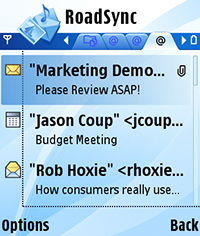
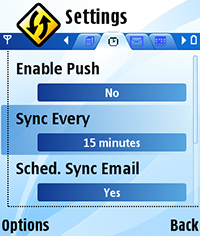
Trend Micro
Trend Micro were showing off their anti-virus and firewall software for S60 3rd Edition. We've commented in the past this really isn't necessary at the moment and remain sceptical as to when, if ever, a real threat will emerge. However, Trend Micro do take a less scaremongering approach than some other security providers and they explained that they feel that they are simply fulfilling market demand. This comes from IT managers in large corporates who demand a security solution before widely deploying mobile devices because it is 'one of the items on the IT policy checklist'. The argument behind this is termed 'pre-emptive protection'; the thinking being that it is better to spend a small amount now on protection as part of a coherent strategy rather than having to spend money later on in retro-fitting security or, worse, spending a large amount money after a problem has occurred (which, if affecting a critical business function, could be very costly indeed).

Zensis
Zensis, a developer based in Hong Kong, was demoing a number of select applications from its portfolio. Zensis has had considerable success in preloading their applications on to handsets delivered by Nokia China (Theme DIY, HotSites and Visual Music Player), Nokia Hong Kong (Animated SMS, Theme DIY), Nokia Taiwan (Theme DIY and Hot Sites) and others. Zensis say that using this route to market can be key in Asian markets where there is little tradition of purchasing additional applications and where software piracy is a significant problem. Zensis were demoing Animated SMS, which adds animations to standard SMS messages (including quite sophisticated overlay animations). The program is very tightly integrated into the existing Messaging application and uses standard SMS to encode the animations. Both users must have the program installed to get the full effect, but the program downgrades gracefully to standard smileys if the receiving party does not have the software.
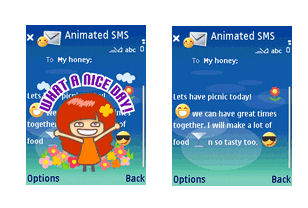
Technical University of Denmark
Jacob Larsen from the Technical University of Denmark was demoing the impressive mobTag concept. It aims to solve the problems that arise when storing more than a couple of dozen photos on an S60 device at the same time. Users familiar with S60 will appreciate that organising photos in Gallery in a logical manner when there are more than 50 media items becomes difficult. mobTag aims to solve this problem by introducing the concept of tagging photos, however it does this with a twist, as it attempts to automate or speed up the process as much as possible. Photos are automatically tagged with context sensitive information such as the current cell ID or GPS position. For manually added tags a library of tags can be created which allows tags to be added much more quickly. This works by pressing a predefined series of keys (e.g. 3-3-6) so that a certain tag can be added. The idea is that this is quicker, and therefore more likely to be used, than writing out each tag in full each time.
After tags have been added, mobTag also uses them to access and display photos more quickly than is possible with traditional solutions. For example, a certain tag can be searched for and the results can subsequently be refined by adding additional tags. Python has been used as a prototyping language in the creation of mobTag to allow rapid development and to experiment with different UI configurations and ideas.
Aalborg University
Aalborg University were showing off how external sensors could be used to feed information to S60 phones. They are developing a standard sensor kit which will allow others to experiment in this area. They are using Python as their prototyping language to carry out tests and create demo applications. The sensor kit itself hosts a programmable DSP, together with Bluetooth connectivity (for talking to phones) and ISM band communication (for talking to other sensors). Different types of sensors can be added (temperature, pressure, distance, etc.) to the platform. The phone as a sensor hub is very compelling given that it is always with you, has a reasonable display and good computational power.
They explained it is possible to create quite complex sensors (the kit allows for a certain amount of pre-processing) but as a basic demo they had created a parking sensor application. This used simple distance sensors, which measured the distance to the nearest wall or obstacle from the four corners of a car. The result were displayed on screen with a simple Python application showing the distance indication changing from green to red as the distance to the obstacle closed and playing an audio warning for the driver.
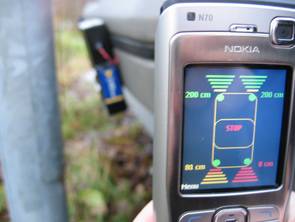
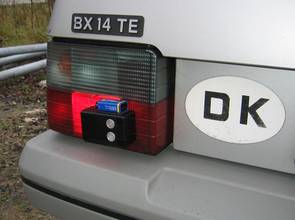
There is additional information about the sensors at this Forum Nokia Blog post and information on the parking sensor demo here.
Lancaster University
Lancaster University were on hand to demo their LocoBlogger service and MobSlinger game. LocoBlogger uses GPS info and a phone's camera to blog in a location aware manner. Images (suitably tagged) are uploaded to a server and then displayed on a map to create a travelogue record of where a user has been. Locoblog was prototyped in Python, but is now available as a JME application from the LocoBlog site (where you can also set up a LocoBlog). MobSlinger is a game which utilises Bluetooth proximity to recreate Wild West shootouts. Players install the game on their phone and then, at random intervals (and in the presence of another playing phone), have to 'draw' their phone and enter a random number to kill the opposing player.More information is available in this Forum Nokia Blog post and on the Mobile Radicals Wiki.
University of California, San Diego
The University of Sand Diego demonstrated how smartphones could play a role in replacing the traditional hospital system of using pagers, together with a network of sensors to monitor patients. The problem with the current system is that it has high infrastructure costs and limited remote ability. The demo showed how the system could be replaced by smartphones (the demo was running in Python on S60) which could directly access sensor data, allowing for easier remote monitoring. Furthermore, it is possible to tailor an alarm situation (i.e. what sensors levels trigger a notification) and provide more information than is possible with a traditional pager system (which can only alert a doctor).
Budapest University of Technology and Economics
Budapest University were demoing their peer to peer applications for S60. They have created SymTorrent (a client/server application to both create and download Torrent files) and Symella (a Gnutella file sharing client). SymTorrent is a well featured and mature application. It supports the downloading of multiple torrent files at the same time, can save the status of your unfinished torrents, so you can resume downloads after restarting the application.
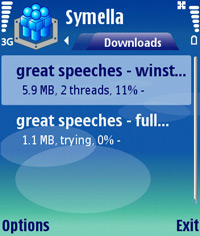
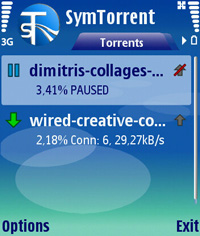
Nokia Research Center
People from the Nokia Research Center were also on hand to demonstrate some of their projects. These include the Wellness Diary (analyses various health data), Nokia Sports Tracker (uses GPS to track exercise), and others. Much of the NRC's activities are carried out in cooperation with universities and often explore ideas at the cutting edge. More information is available on the NRC website.Rafe Blandford, AllAboutSymbian, 3rd May 2007
